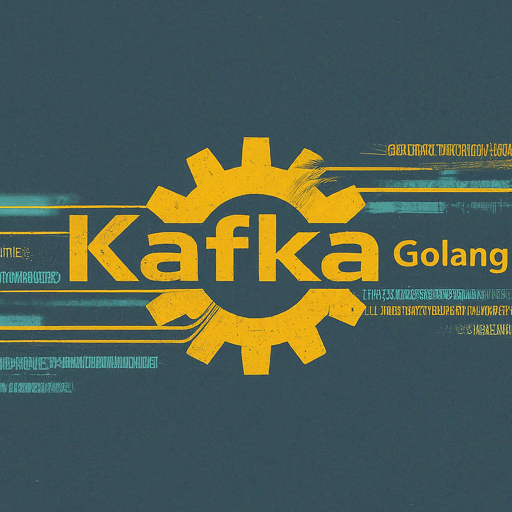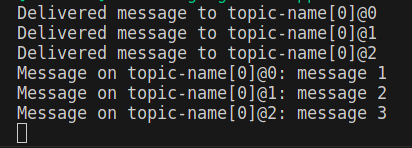Connect Kafka with Golang
Introduction
If you need to know the basics of Kafka, such as its key features, components, and advantages, I have an article covering that here. Please review it and follow the steps until you've completed the Kafka installation using Docker to proceed with the following sections.

Connecting to Kafka with Golang
Similar to the example in the article about connecting Kafka with NodeJS, this source code also includes two parts: initializing a producer to send messages to Kafka and using a consumer to subscribe to messages from a topic.
I'll break down the code into smaller parts for better understanding. First, let's define the variable values.
package main import ( "fmt" "github.com/confluentinc/confluent-kafka-go/kafka" ) var ( broker = "localhost:9092" groupId = "group-id" topic = "topic-name" )
- Here, the package github.com/confluentinc/confluent-kafka-go/kafka is used to connect to Kafka.
- The broker is the host address; if you are using ZooKeeper, replace the host address accordingly.
- The groupId and topic can be changed as needed.
Next is initializing the producer.
func startProducer() {
p, err := kafka.NewProducer(&kafka.ConfigMap{"bootstrap.servers": broker})
if err != nil {
panic(err)
}
go func() {
for e := range p.Events() {
switch ev := e.(type) {
case *kafka.Message:
if ev.TopicPartition.Error != nil {
fmt.Printf("Delivery failed: %v\n", ev.TopicPartition)
} else {
fmt.Printf("Delivered message to %v\n", ev.TopicPartition)
}
}
}
}()
for _, word := range []string{"message 1", "message 2", "message 3"} {
p.Produce(&kafka.Message{
TopicPartition: kafka.TopicPartition{Topic: &topic, Partition: kafka.PartitionAny},
Value: []byte(word),
}, nil)
}
}
The above code is used to send an array of messages {"message 1", "message 2", "message 3"} to a topic and uses a go-routine to iterate through events with for e := range p.Events() and print out the delivery result, whether it's a success or failure.
Next is creating a consumer to subscribe to the topic and receive messages.
func startConsumer() {
c, err := kafka.NewConsumer(&kafka.ConfigMap{
"bootstrap.servers": broker,
"group.id": groupId,
"auto.offset.reset": "earliest",
})
if err != nil {
panic(err)
}
c.Subscribe(topic, nil)
for {
msg, err := c.ReadMessage(-1)
if err == nil {
fmt.Printf("Message on %s: %s\n", msg.TopicPartition, string(msg.Value))
} else {
fmt.Printf("Consumer error: %v (%v)\n", err, msg)
break
}
}
c.Close()
}
Finally, since this is a simple example, call the functions to create the producer and consumer for use. In a real-world scenario, the deployment of the producer and consumer is typically done on two different servers in a microservices system.
func main() {
startProducer()
startConsumer()
}

Happy coding!
If you found this content helpful, please visit the original article on my blog to support the author and explore more interesting content.





Some series you might find interesting:
- NodeJS
- React
- Docker
- Kubernetes
The above is the detailed content of Connect Kafka with Golang. For more information, please follow other related articles on the PHP Chinese website!

Hot AI Tools

Undresser.AI Undress
AI-powered app for creating realistic nude photos

AI Clothes Remover
Online AI tool for removing clothes from photos.

Undress AI Tool
Undress images for free

Clothoff.io
AI clothes remover

Video Face Swap
Swap faces in any video effortlessly with our completely free AI face swap tool!

Hot Article

Hot Tools

Notepad++7.3.1
Easy-to-use and free code editor

SublimeText3 Chinese version
Chinese version, very easy to use

Zend Studio 13.0.1
Powerful PHP integrated development environment

Dreamweaver CS6
Visual web development tools

SublimeText3 Mac version
God-level code editing software (SublimeText3)

Hot Topics
 1671
1671
 14
14
 1428
1428
 52
52
 1329
1329
 25
25
 1276
1276
 29
29
 1256
1256
 24
24
 Golang vs. Python: Performance and Scalability
Apr 19, 2025 am 12:18 AM
Golang vs. Python: Performance and Scalability
Apr 19, 2025 am 12:18 AM
Golang is better than Python in terms of performance and scalability. 1) Golang's compilation-type characteristics and efficient concurrency model make it perform well in high concurrency scenarios. 2) Python, as an interpreted language, executes slowly, but can optimize performance through tools such as Cython.
 Golang and C : Concurrency vs. Raw Speed
Apr 21, 2025 am 12:16 AM
Golang and C : Concurrency vs. Raw Speed
Apr 21, 2025 am 12:16 AM
Golang is better than C in concurrency, while C is better than Golang in raw speed. 1) Golang achieves efficient concurrency through goroutine and channel, which is suitable for handling a large number of concurrent tasks. 2)C Through compiler optimization and standard library, it provides high performance close to hardware, suitable for applications that require extreme optimization.
 Getting Started with Go: A Beginner's Guide
Apr 26, 2025 am 12:21 AM
Getting Started with Go: A Beginner's Guide
Apr 26, 2025 am 12:21 AM
Goisidealforbeginnersandsuitableforcloudandnetworkservicesduetoitssimplicity,efficiency,andconcurrencyfeatures.1)InstallGofromtheofficialwebsiteandverifywith'goversion'.2)Createandrunyourfirstprogramwith'gorunhello.go'.3)Exploreconcurrencyusinggorout
 Golang vs. C : Performance and Speed Comparison
Apr 21, 2025 am 12:13 AM
Golang vs. C : Performance and Speed Comparison
Apr 21, 2025 am 12:13 AM
Golang is suitable for rapid development and concurrent scenarios, and C is suitable for scenarios where extreme performance and low-level control are required. 1) Golang improves performance through garbage collection and concurrency mechanisms, and is suitable for high-concurrency Web service development. 2) C achieves the ultimate performance through manual memory management and compiler optimization, and is suitable for embedded system development.
 Golang's Impact: Speed, Efficiency, and Simplicity
Apr 14, 2025 am 12:11 AM
Golang's Impact: Speed, Efficiency, and Simplicity
Apr 14, 2025 am 12:11 AM
Goimpactsdevelopmentpositivelythroughspeed,efficiency,andsimplicity.1)Speed:Gocompilesquicklyandrunsefficiently,idealforlargeprojects.2)Efficiency:Itscomprehensivestandardlibraryreducesexternaldependencies,enhancingdevelopmentefficiency.3)Simplicity:
 Golang vs. Python: Key Differences and Similarities
Apr 17, 2025 am 12:15 AM
Golang vs. Python: Key Differences and Similarities
Apr 17, 2025 am 12:15 AM
Golang and Python each have their own advantages: Golang is suitable for high performance and concurrent programming, while Python is suitable for data science and web development. Golang is known for its concurrency model and efficient performance, while Python is known for its concise syntax and rich library ecosystem.
 Golang and C : The Trade-offs in Performance
Apr 17, 2025 am 12:18 AM
Golang and C : The Trade-offs in Performance
Apr 17, 2025 am 12:18 AM
The performance differences between Golang and C are mainly reflected in memory management, compilation optimization and runtime efficiency. 1) Golang's garbage collection mechanism is convenient but may affect performance, 2) C's manual memory management and compiler optimization are more efficient in recursive computing.
 The Performance Race: Golang vs. C
Apr 16, 2025 am 12:07 AM
The Performance Race: Golang vs. C
Apr 16, 2025 am 12:07 AM
Golang and C each have their own advantages in performance competitions: 1) Golang is suitable for high concurrency and rapid development, and 2) C provides higher performance and fine-grained control. The selection should be based on project requirements and team technology stack.




